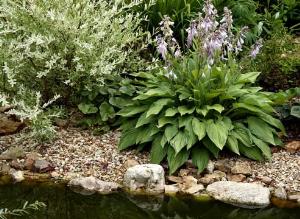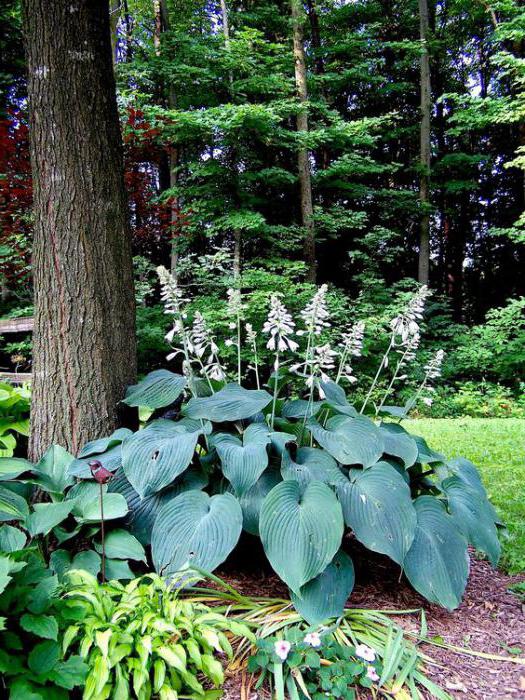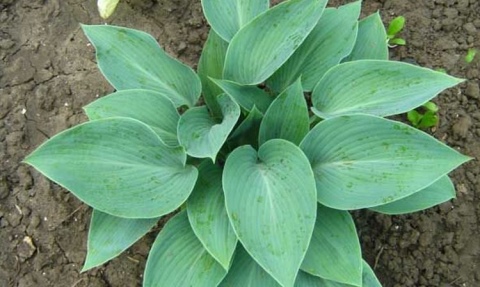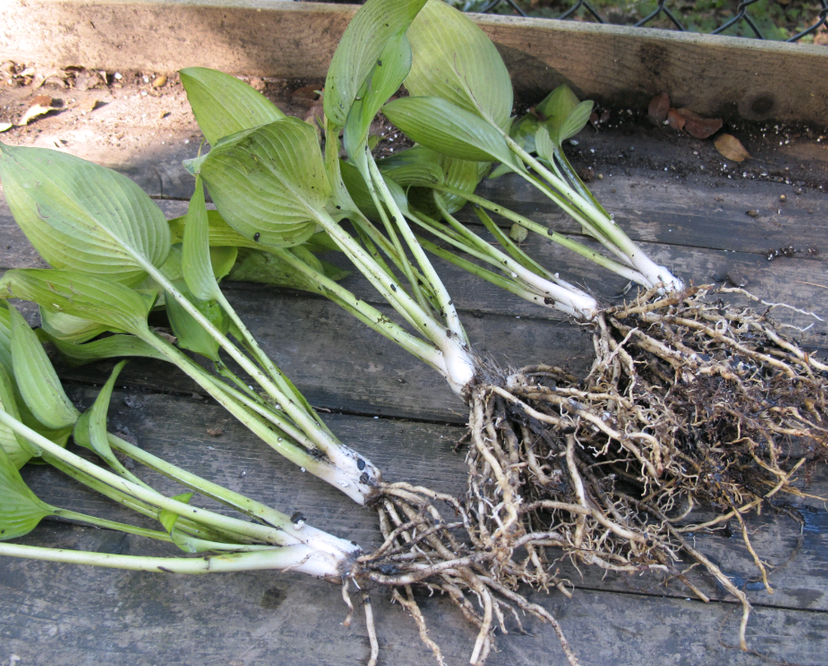Care rules
Watering
For 3 weeks, young plantings are watered every other day to help them take root and grow faster.

Hosta blue angel
Considering that this is a moisture-loving culture, from spring to autumn it is moistened twice a week, provided that the summer is dry.
On hot days, the hostu is sprinkled with warm water to maintain its decorative qualities and to avoid wilting. The procedure is carried out in the evening when the sun goes down.
The soil around the bushes is regularly loosened so that it allows moisture and oxygen to pass through well. At the same time, weeds are removed, the aisles are weeded, and mulch (peat or leaf compost) is added, which protects the soil from rapid drying out.
Top dressing
The blue angel host does not need to be fed, but regular feeding will increase its decorative qualities and stimulate rapid growth. Fertilizers can be applied 3-4 times per season:
- in early spring, the land is enriched with liquid nitrogen preparations - a solution of bird droppings (1:20), slurry (1:10);
- before and after flowering, they are fed with a mixture of superphosphate and potassium sulfate - 15 g per bucket of water;
- in the fall, rotted manure or leaf compost is placed in the trunk circle.
Pruning
The host does not need to be configured, because initially develops a beautiful, compact crown. Throughout the entire period of growth and development, only non-viable parts are removed that have withered, turned yellow, rotted or have been damaged by diseases.
Planting and grooming recommendations
Any soil is suitable for blue hosts. It is worth noting that on sandy soil, the bluish-blue color of the leaves of the funkia will be more saturated, but the size of the bush will be smaller. Hosta should not be planted in places with stagnant moisture (flooded in spring with melt water, where water flows from the roof and with high groundwater).
You can plant blue funkia in open ground in spring (April-May) and autumn (August-September).
For planting, it is necessary to dig a spacious hole of such a diameter that the roots of the plant are freely located in it. Pour a little humus, peat and complex fertilizer into it. Water the hole abundantly. Put the hosta in the center, gently spread the roots and cover it with an earthen substrate. The root collar should be at ground level.
Until the hosta takes root, it needs to be watered often: every 3 days. It is not necessary to mulch the soil under the funkion: this can cause rotting of the root collar.
Subsequent care of the funkia consists in timely weeding, watering, and top dressing.
The host will not have to weed the blue host often. Since it covers the surface of the soil with its leaves, weeds hardly grow under it.
It is necessary to water it as the substrate completely dries out in the hole. Watering is required abundant. It must be produced at the root of the plant. Where water droplets touch the leaves, the blue plaque will be erased and the foliage will lose its decorative effect.
You can fertilize the host 4 times per season. To do this, you can use a ready-made complex fertilizer (following the instructions on the package) or mullein infusion (diluted with water in a ratio of 1: 10). Top dressing should be added to wet soil early in the morning. Foliar dressing can be carried out only on the lower part of the leaf blade in order to avoid the loss of the beautiful blue color.
The function is frost-resistant enough, therefore, does not require shelter before wintering. But in the fall, when the leaves turn yellow and wilt completely, they can be cut off to preserve the decorative effect of the flower garden.
CATS-MOUSE
There is a whole "mouse family" in the host world, the progenitor of which was a unique mini-variety with an absolutely ingenious name - Blue mouse ears ("Blue mouse ears").
He got such a name for a reason: round, dense, elastic, like silicone, leaves really resemble the ears of Mickey Mouse, the hero of Disney cartoons. It is characteristic that this variety belongs to the mini-host group, and its lavender flowers and tall peduncles are disproportionately large, just like those of the "adult" hosts. The tremendous commercial success of these "ears" prompted the originators to create new mini-varieties with similar characteristics.
The list of hosts from the mouse series is so long that they have become a separate collectible. it Snow mouse ("Snow mouse") with dense leaves with a white center and a blue-green border; Green mouse ears ("Green mouse ears") - a dark green variety with thick elastic leaves and large purple flowers; Lucky mouse ("Lucky mouse"), Holy mouse ears ("Holy mouse ears"); new in 2013 with a bright memorable name Church mouse ("Church mouse"), Country mouse ("Country mouse"), Dancing Mouse ("dancing mouse"), Frosted Mouse Ears ("frostbitten mouse ears") with green-blue round leaves with a cream border and pink flowers; Giantland Sunny Mouse Ears ("Solar mouse ears") became the first yellow-leaved host from the mouse family; Desert Mouse ("desert mouse"), Mystic mouse ("Mysterious mouse"), Mighty Mouse ("Mighty mouse") - all these offspring Blue mouse ears.
Known since 2014 Giantland Mouse Cheese ("Mouse cheese"). In 2016 appeared Smiling mouse ("Smiling mouse") - sport from Frosted Mouse Ears... New products of 2017 are Sun mouse ("Solar mouse"), another variety with golden yellow leaves; School mouse ("School mouse"); Flamenco Mouse... But all this “mouse fraternity”, in my opinion, is inferior in beauty and originality to its progenitor.
Where there are mice, cats must also appear. Some of them are straight out of the mouse series. It is a miniature Cat and Mouse variety as well as a dwarf Cats Eyes ("Cat's eyes"), with an expressive pattern on the resembling almond-shaped cat's eyes.

MINI HOSTS - CARE
Small hosts require much more attention, than their larger cousins. All of them have a small root system, which is very sensitive to moisture deficiency (but its excess also adversely affects the plant - it is not known which is worse). It is better to cover these hosts for the winter with fallen leaves, protecting the delicate roots from frost. And in the spring, it is imperative to mulch, but with a small layer of compost or peat (no more than 2 cm thick) - this will allow you to maintain an optimal soil moisture regime and fight annual weeds. Around it is still worth additionally crumbling the ground with crushed bark, sawdust or walnut shells. This will be an effective barrier for slugs, who are able to destroy the entire mini-host collection in literally one night! They just love to feast on tender leaves of cute defenseless crumbs.
They must be planted in a heap (so that they are not lost in flower beds), enclosing them with a dug-in plastic tape or making an impromptu "fence" of sticks stuck around them. And the best thing is to place small hosts in a plastic pot without a bottom (it will break the ceramics with frost), and cut off at least half of it, leaving a ring that must be buried in such a way that there are 7-10 centimeters above the ground.
Reference by topic: New host varieties - photos, names and descriptions
This barrier will be an insurmountable obstacle for slugs. There may be several such improvised "flower beds", plant 3-5 hosts in each (depending on their size), arranging them according to the color and shape of the leaves and achieving color harmony. And all of them should be located amicably, together, in partial shade conditions suitable for them.
This measure is obligatory, since in the spring there is a great chance to simply inadvertently trample the little ones: they don't need much ...
And in no case should you cut off their foliage in the fall. Firstly, because they themselves, so clever, shelter themselves with it from the winter cold. And secondly, dried and mummified leaves lie flat on the ground, indicating the location of the hosta. In spring it is easy to remove them with one movement of the hand, but only after the “noses” have hatched.
Landing features
The success of perennial cultivation depends on several factors - the quality of the planting material, the location and composition of the soil.

Hosta blue angel
Timing
The best time for planting seedlings is from mid-April to the second decade of May, when the ground warms up well and the threat of return frosts is over. So you eliminate the risk of freezing of the delicate and not yet matured root system of young plants.
Place and soil
In the wild, the bush grows in shady forests, near lakes, on moist soil. He needs to provide the same conditions in the garden.
It is better to plant under tall trees, shrubs, near a fence or a gazebo, where in the afternoon there is full shade. In the sun, its delicate foliage will quickly fade and turn yellow.
Grows well in loose, drained soil with a high humus content
It is important that the acidity level is neutral. Therefore, if necessary, the soil is deoxidized with chalk, slaked lime or dolomite flour - 350 g per 1 m²
If the ground is knocked down and heavy, it is necessary to improve its structure with sand, perlite or vermiculite - 2 buckets per 1 m².
Before planting, the site is freed from garden debris, dug deeply and leveled.
Seedling preparation
You can buy planting material at a gardening store. Choose seedlings with unopened buds - they take root better after transplanting than plants with foliage
It is important that they are juicy, fresh without yellowness, black spots and dried out fragments.
Buy hosts with earthy clods or planted in containers - they quickly adapt after planting in the garden. In addition, the root system is protected from drying out until it is planted in open ground.
The pot is crumpled to facilitate the extraction of the roots, then the rhizome is dipped in cold water for an hour. The longest roots are pruned 2-3 cm in order to stimulate the further development of new shoots.
Landing technique
Pits are dug at a distance of 1.5-2 m so that the bushes can fully develop without competition for moisture and space.
Their depth and width should be twice as large as the roots. Each hole is filled by a third of its volume with a nutrient composition - peat and leaf compost are mixed in equal amounts. It is poured with a mound, the root system is installed on top, straightened, covered with the remaining fertile soil, trampled, watered. 5 liters of water are poured under one bush.
At the end, add mulch to prevent rapid evaporation of moisture. Use shredded bark or peat.
When planting, it is important that the buds are at the level of the ground; when they are buried, there is a high risk of decay and death of the entire bush. In the first two weeks, unstable seedlings are very sensitive to sunlight, so at noon they are shaded with burlap or agrofibre
In the first two weeks, unstable seedlings are very sensitive to sunlight, so at noon they are shaded with burlap or agrofibre.
Reproduction
A hybrid host can be propagated in three ways:
- seeds;
- cuttings;
- dividing the bush.
Most often, gardeners resort to dividing the bush. These manipulations can be performed in early spring or at the very end of summer. It is best to divide the roots with a pitchfork, since the risk of damaging them is minimal. It is not at all necessary to dig out the entire bush - the detachable part is quite enough, and the resulting void can be filled with a mixture of river sand and peat.
In the process of dividing, the cuttings are sometimes broken off, leaving a "root heel". They can be placed in a water bottle and covered with a greenhouse. After a short period of time, they will give roots, at this moment you can cut off the leaf, then rooting will go faster.
At the same time, you have absolutely no guarantee that a plant similar to the mother will turn out from the planting material.
Care in the garden from the moment of planting in the open ground
Phloxes require regular watering, therefore, such flowers are not suitable for lazy summer residents.
Young plants should be the subject of constant care of the grower. Regular watering is needed, but waterlogging of the soil should not be allowed - excessive dampness often causes fungal diseases.2-3 treatments of plants with a solution containing growth stimulants will be useful. Of the fertilizers, preference is given to nitrogenous compounds - they help the flower quickly gain green mass.
Weeding is necessary so that weeds do not take away nutrients, water and sunlight from young plants. Weed removal should be combined with loosening, since light, air-saturated soil is a priority for phlox.
How to care during growth and flowering
So that the phlox stems do not interfere with each other, they should be thinned out, leaving the strongest
Lush bloom of phlox is impossible without regular generous watering (1 bucket of water per 1 sq. M.), At least in 4–5 days. In addition, fertilizing with fertilizers intended for flowering crops is mandatory. It is necessary to very accurately observe the dosage indicated on the packages, since if the norm is exceeded, the nitrogen contained in the fertilizers has a positive effect on the foliage, and the flowering will be modest. By the end of summer, you need to focus on fertilizers with potassium - such a top dressing will help phlox bloom longer, and their inflorescences will become brighter.
Since phlox have been grown in Russian gardens for a very long time, a folk recipe that has stood the test of time will be appropriate. In order for the plants to bloom magnificently, you need to take 100 g of rye bread, soak it in 1 liter of water, leave for a day, and then use it for root watering.
To preserve the decorative effect, faded brushes should be regularly removed. And you also need to prune excess shoots from time to time so that the shape of the bush is better, and the flowering lasts longer.
Video: secrets of the lush flowering of phlox
Care after the plants have faded
Some varieties of phlox require additional shelter before winter.
The actions of the grower at this time are reduced to preparing the plant for winter. After the end of flowering, the ground part of the phlox is cut off, and immediately before the onset of cold weather, they are covered with some covering material: temperatures from –20 ° C and below can destroy the roots.
What problems do gardeners have with growing phlox
Yellowing of the foliage can indicate not only a lack of watering, but also diseases of a viral nature.
Although phloxes are not the most capricious plants, they can also have problems. Here is some of them:
- The trunk (stem) cracks - the plantings are too thick and there is not enough food for all the plants. The way out is to carry out decimation.
- The lower leaves dry out - irregular watering, according to the principle "now thick, now empty." The way out is to water the flowers regularly and evenly.
- Leaves wither and fade - there is a high probability of a fungal infection. The way out is to add a little lime to the soil, and if the plant is badly damaged, remove it from the flower bed along with a lump of earth and burn it.
- The tops of the shoots become thin and twisted - the plant is infected with stem nematode. The way out is to cut and destroy the affected areas, and transplant the plant itself. Place nasturtiums or marigolds nearby, these are natural healers.
- Flowering has become less lush - perhaps the plant has been in one place for more than 6-7 years. Exit - transfer to another territory.
It is difficult to imagine a modern garden without phlox: bright, varied, fragrant. For garden compositions, these plants are also irreplaceable because they are good neighbors of other perennials: roses, lilies, irises.










































